Chapter 5
Influence of body
roll on visually induced self-tilt
Introduction
A stationary observer exposed to
a rotating scene experiences self-rotation, or circularvection in the opposite
direction and perceives the scene as stationary (Fischer and Kornmüller
1930). It generally takes 20-30 s for vection to reach its full strength, which
is ascribed to the absence of the vestibular inputs that would accompany actual
self rotation during this initial period (Dichgans and Brandt 1978). Because
the semicircular canals do not respond to steady rotation of the body, the relative
motion of the visual surroundings is the only cue to steady passive rotation
about a vertical axis. Therefore, during circularvection about a vertical axis
there is a visual-vestibular conflict only at the onset of the visual motion.
Accordingly, the latency of circularvection can be shortened by an impulsive
rotation of the body in the same direction (Brandt et al. 1974).
Circularvection about a horizontal
axis is more complicated, because it affects the perceived orientation of the
body with respect to gravity. This not only involves inputs from the semicircular
canals, but also from the otolith organs. The otoliths register the steady state
orientation of the head relative to gravity, and thus contradict visually induced
sensations of self-tilt in a stationary observer. As a consequence, rotation
of the visual surroundings about a horizontal axis typically produces a sensation
of continuous self-rotation accompanied by constant illusory self-tilt with
a mean value of about 20º (Dichgans et al. 1972; Held et al. 1975).
Moreover, the magnitude of circularvection has been found to be smaller for
rotations about a horizontal axis than for rotations about a vertical axis (Held
et al. 1975; Howard et al. 1988). Because of the persisting visual-otolith
conflict, it is questionable whether passive body rotation at the onset of the
visual motion can enhance visually-induced sensations of self-rotation and self-tilt
about a horizontal axis, as it does for circularvection about a vertical axis.
In the present study we addressed this question for rotation about the line
of sight (roll axis) in an upright observer.
In flight simulators with a motion
base, vestibular onset cues are applied to enhance sensations of self-motion.
A motion base has limited travel and must be returned to its original position
after a maneuver without disturbing the sensation of self-motion. This is done
by an acceleration below the vestibular threshold, a procedure known as washout.
We examined the effects of washout temporally separated from the onset by delaying
the restoration of the body position. The effective vestibular stimulus to body
roll can be decomposed into a rotation component and a tilt component. It was
hypothesized that the magnitude of circularvection primarily depends on initial
body acceleration in the washout maneuver, whereas the extent of perceived self-tilt
primarily depends on the angle of body tilt. To investigate this hypothesis
we exposed subjects to whole-field visual rotation about the horizontal roll
axis and superimposed two acceleration levels of body roll, one above the vestibular
threshold and one in the threshold region.
Adapted from: Groen E, Howard IP, Cheung B. Effects of actual
body roll on visually induced self-tilt. Submitted to Journal of Vestibular
Research.
Method
Stimulus
The subject sat inside a 9-foot diameter
sphere lined with black dots on a white surface. The seat was padded with "slow
recovery" plastic foam and the subject was constrained by a five-point
harness and head rest with the head upright and close to the center of the sphere.
The sphere was illuminated by a 60 watt light bulb placed above and behind the
subject's head. The sphere and chair could be rotated independently about the
same earth-horizontal axis. The rotation axis passed through the center of the
sphere and was parallel to the subject’s roll axis centered on the subject’s
head. There were seven conditions (Table 5.1). The effect of visual motion itself
was investigated in one condition in which the sphere alone rotated ("visual
motion"). The effect of body motion was investigated in two conditions,
in which the subject alone rotated ("subject motion"). The effect
of washout was investigated in three "washout conditions", in which
both the sphere and the subject rotated. In two washout conditions the washout
was delayed for 40s ("delayed-washout"), and in the third condition
the washout immediately followed the onset ("immediate-washout").
Finally, the effect of body tilt without washout was investigated in a condition
in which the subject was tilted before the sphere was accelerated, and restored
to upright after deceleration of the sphere ("pre-tilt"). The sphere
accelerated at 3º/s2 until it reached a terminal velocity of 18º/s
which was maintained for 80 s before deceleration. The subject was accelerated
at either 0.7º/s2 ("subthreshold") or 3º/s2
("suprathreshold"). We selected an acceleration of 0.7º/s2
because it is in the threshold region for detection of self rotation about the
roll axis and takes over 1 s to detect. An acceleration of 3º/s2
is detected in under 0.1 s (Gundry 1978).
|
Condition |
Onset |
Washout |
|
1 Visual-motion |
Sphere accelerated at 3º/s2 to constant velocity of 18º/s. Chair stationary. |
After 80s sphere decelerated at 3º/s2 to stop. |
|
2 Subject-motion suprathreshold |
Chair accelerated/decelerated at 3º/s2 to 15º of tilt (in 4.5s). Sphere stationary and visible. |
After 40s chair accelerated/decelerated in reverse to the vertical. |
|
3 Subject-motion subthreshold |
Chair accelerated/decelerated at 0.77º/s2 to 15º of tilt (in 8.8s). Sphere stationary and visible. |
After 40s chair accelerated/decelerated in reverse to the vertical. |
|
4 Delayed-washout suprathreshold |
Chair motion as in 2.
Synchronous acceleration of sphere to constant velocity of 18º/s (acceleration of sphere relative to chair was 3º/s2). |
Chair motion as in 2.
Sphere motion relative to the chair kept constant at 18º/s and maintained for a further 40s. |
|
5 Delayed-washout subthreshold |
Chair motion as in 3.
Synchronous acceleration of sphere to constant velocity of 18º/s (acceleration of sphere relative to chair was 3º/s2). |
Chair motion as in 3.
Sphere motion relative to the chair kept constant at 18º/s and maintained for a further 40s. |
|
6 Immediate-washout |
Chair motion as in 2.
Synchronous acceleration of sphere to constant velocity of 18º/s (acceleration of sphere relative to chair was 3º/s2). |
Immediately after onset phase, the chair accelerated/decelerated at 0.77º/s2 back to the vertical. Sphere motion relative to the chair kept constant at 18º/s and maintained for a further 40s. |
|
7 Pre-tilt |
Chair motion as in 2.
After 20s the sphere accelerated at 3º/s2 to constant velocity of 18º/s. |
Sphere motion maintained for 40s and stopped. Subject remained tilted 15º for a further 30s. |
Table 5.1. Acceleration
profile of chair and sphere in onset-phase and washout-phase in the concordant
motion conditions. Chair tilt was achieved by constant acceleration up to half
the final tilt angle of 15º, followed by constant deceleration of equal magnitude.
The subject was accelerated and then
decelerated to a tilt angle of 15º. This is designated the onset phase of the
washout trial. In the onset phase the sphere accelerated in the opposite direction
so that the acceleration of the sphere relative to the subject was always 3º/s2.
In the delayed-washout conditions, the body tilt of 15º was maintained for 40s
while the sphere rotated at a constant velocity of 18º/s. This is the post-onset
phase of the trial. After 40s the subject returned to the vertical with the
same acceleration/deceleration sequence as in the onset phase. Simultaneously,
the sphere was accelerated/decelerated to keep its velocity relative to the
subject constant. This is the washout phase of a trial. After the subject came
to a stop in the upright position, the sphere continued to rotate at 18º/s for
a further 40s. This is the post-washout phase of the trial. In the immediate-washout
condition, the suprathreshold onset phase was immediately followed by a subthreshold
washout phase, so that the subject was upright for the remaining 80s of sphere
rotation at 18º/s. This condition most closely resembles washout sequences used
in flight simulators. Finally, in the "pre-tilt" condition the subject
was tilted to 15º about the roll axis with the sphere stationary. After 20s
the sphere motion was initiated and maintained at 18º/s for 40s and stopped
while the subject remained tilted.
In the above washout conditions,
the sphere and the subject rotated in opposite directions. This was designated
"concordant motion", because both motions produced sensations of self-motion
in the same direction. We added two "discordant motion" conditions,
in which the sphere and the body moved in the same direction. To keep the relative
acceleration between the subject and the sphere comparable to that in the concordant
conditions, the sphere accelerated faster than the chair, which created self-tilt
in the opposite direction to the subject motion. In one discordant condition
the body was tilted at subthreshold acceleration, and in the other at suprathreshold
acceleration.
The velocity profiles of the
subject and sphere for the concordant conditions are set out in Figure 5.1.
The corresponding position profiles of the subject are shown in Figure 5.2.
All conditions were performed with the light on. Each condition was run twice,
once for clockwise and once for anti-clockwise motion of the sphere. The order
of conditions was counterbalanced over subjects.
Responses
Subjects were asked to report verbally
the magnitude of perceived body tilt and vection. The reports were taken 20
s after each acceleration-deceleration onset phase or restoration phase during
the time of constant body posture and constant sphere rotation. It was assumed
that the post-acceleration effects of the semicircular canals had faded after
20 s. The angle of self-tilt was expressed in degrees by all but two subjects,
who preferred to use a scale based on half-hour
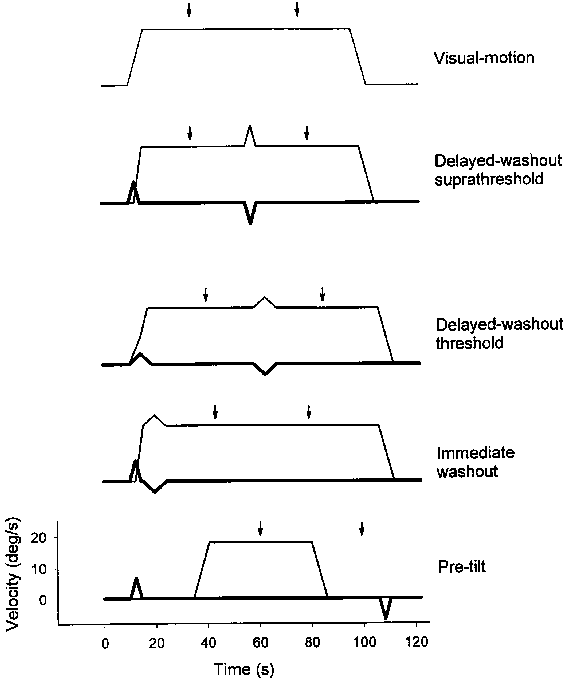
Figure 5.1. Velocity profiles
of sphere (thin line) and chair (bold line) for concordant conditions. To indicate
relative velocity, the same sign is used for sphere and chair velocity, although
they rotated in opposite directions. The supra- and subthreshold subject-motion
conditions are not shown, but the velocity profiles of the chair were the same
as in the supra- and subthreshold delayed-washout conditions, respectively.
The arrows indicate when the subject reported perceived self-tilt and vection.
In all but the pre-tilt condition, there were two test phases.
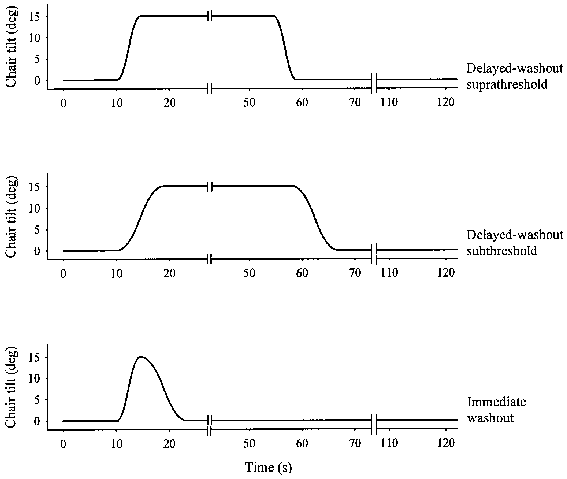
Figure 5.2. Position
profiles of the chair. In the supra- and subthreshold conditions, the chair
was tilted to 15º and kept in that position throughout the 40 s post-onset phase,
before the upright position was restored. In the immediate-washout condition
the chair was tilted at a suprathreshold acceleration, and immediately tilted
back to upright at a subthreshold acceleration.
intervals of the hour
hand of a clock. Vection was expressed by a five-point scale as shown in Table
5.2. Subjects were also asked to keep a tactile rod aligned with the perceived
vertical. The rod was 20 cm long and placed to the side of the subject’s right
knee. The rod was not quite out of sight but subjects were asked not to pay
visual attention to it. The first movement of the rod indicated the latency
of illusory self-tilt at the beginning of each trial and the magnitude of rod
tilt provided a measure of the perceived vertical which could be related to
the verbal estimates.
|
Vection value |
Experience |
|
0 |
All motion in the sphere |
|
1 |
Sphere moves faster than subject |
|
2 |
Subject and sphere move at same velocity in opposite directions |
|
3 |
Subject moves faster than sphere |
|
4 |
All motion in subject |
Table 5.2.
The five-point vection scale
Results
Twelve subjects participated in the
experiment, seven men and five women between ages of 24 and 60. One subject
had to withdraw because of developing nausea. The data from another subject
were excluded from the analysis because she experienced full self-rotation in
all conditions, probably because she confused vection with illusory self-tilt.
A third subject felt supine in about half of the conditions, and the perceived
tilt data were entered as missing. Her vection and latency data were used.
Latency
The mean values and standard errors
of the 10 subjects are shown in Figure 5.3 for the latency of perceived tilt,
as indicated by settings of the tactile rod. The latency in the visual-motion
condition was significantly longer than in the washout conditions (within subjects
design ANOVA; F=9.91; df=3,6; p<0.01). A post-hoc Tukey test revealed a difference
between the visual-motion condition and suprathreshold delayed-washout condition
and between the visual-motion condition and the immediate-washout condition
(p<0.05), but not between the visual-motion and the subthreshold delayed-washout
condition. There was no difference in latency between the visual motion and
the pre-tilt condition. The latency was longer in the subthreshold subject-motion
and washout conditions than in the suprathreshold subject-motion and washout
conditions (F=47.13; df=1,4; p<0.01). There was no difference between the
suprathreshold delayed-washout condition and the immediate-washout condition.
There was no main effect of acceleration
level of the subject on the angle of perceived self-tilt in the post-onset phase
of both subject-motion and delayed-washout conditions. The magnitude of perceived
self-tilt was greater in a tilted body position than in an upright body position,
according to a significant difference between the delayed-washout conditions
and the visual-motion condition (tactile rod: F=6.37; df=2,18; p<0.01; verbal
estimate: F=7.22; df=2,18; p<0.01). In the pre-tilt condition the angle of
perceived tilt as indicated by the tactile rod (but not the verbal estimate)
was significantly greater than in the visual-motion condition (F=20.15; df=1,9;
p<0.01) and also greater than in the delayed-washout conditions (F=4.47;
df=2,18; p<0.05). However, in neither the delayed-washout conditions nor
in the pre-tilt condition, was perceived self-tilt greater than the sum of the
visual-motion condition and the suprathreshold or subthreshold subject-motion
condition, respectively. Perceived tilt in the immediate-washout condition was
not different from that in the visual-motion condition, indicating that the
effect of actual body tilt disappeared after washout.
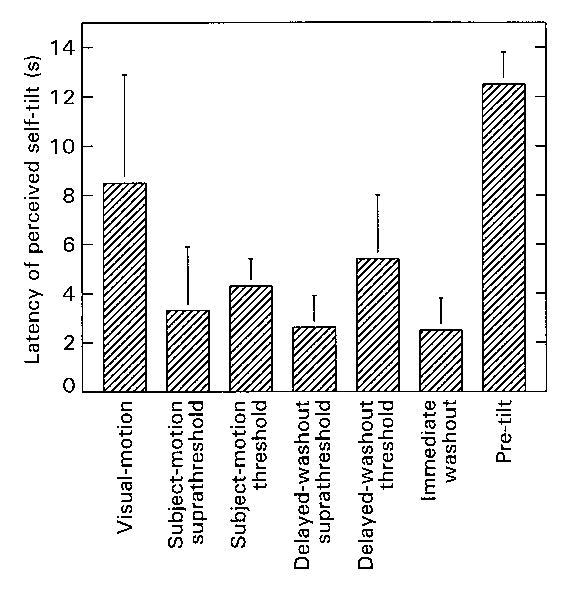
Figure 5.3. Mean latency of perceived self-tilt in the concordant-motion
conditions. The bars indicate standard errors of the means (n=10).
Perceived
self-tilt
The results for the magnitude of
perceived self-tilt, as indicated by settings of the tactile rod and by the
verbal estimate, are shown in Figs. 5.4a and b, respectively. Verbal estimates
were consistently higher than estimates derived from settings of the tactile
rod. For instance, in the post-onset phase of the subject-motion conditions
the mean perceived tilt indicated by the settings of the tactile rod was 10.3º,
while the verbal estimate amounted to 21.9º (F=15.12; df=1,9; p<0.01). In
general, the two measures varied in a similar way with experimental conditions.
In both subject-motion conditions,
restoration of the subject to vertical resulted in a significant decrease in
perceived self-tilt to about zero (tactile rod: F=17.44; df=1,9; p<0.01;
verbal: F=27.96; df=1,9; p<0.001). In the delayed-washout conditions, the
perceived tilt was smaller in the post-washout phase than in the post-onset
phase for both verbal (F=20.0; df=1,8; p<0.01) and tactile judgments (F=6.14;
df=1,9; p<0.05), and was no longer different from the judgments in the visual-motion
condition. There was no effect of acceleration level on the perceived tilt in
the post-washout phase.
Magnitude of vection
The mean vection magnitudes are shown
in Figure 5.5. In the post-onset phase there were no differences between the
various conditions. On average, vection magnitude was about 2.5, indicating
that the subjects experienced slightly more self motion than sphere motion.
Washout seemed to reduce the vection magnitude: in the suprathreshold and subthreshold
delayed-washout condition, the mean values before washout were 2.4 and 2.7,
respectively, and became 1.8 and 1.9 after washout. This difference, however,
did not reach significance.
Discordant conditions
Subjects were very confused in the
discordant conditions. According to the verbal reports, the direction of perceived
body tilt was initially determined by the tilting chair, but then quickly changed
sign and became determined by the visual stimulus. But even during the constant
velocity phase, subjects did not have much
confidence in their judgments. They
felt tilted to one side (visually induced) and pressure to the other side. As
a consequence, the subjects indicated that they were guessing when they set
the tactile rod to the vertical, and they often failed to move it. Therefore,
only verbal estimates were analyzed.
The magnitude of estimated self-tilt
in the post-onset phase varied around zero (1.9 ±3.5 in suprathreshold condition;
-2.4 ±7.0 in subthreshold condition). This suggests that the visual stimulus
roughly canceled the self-tilt induced by the body
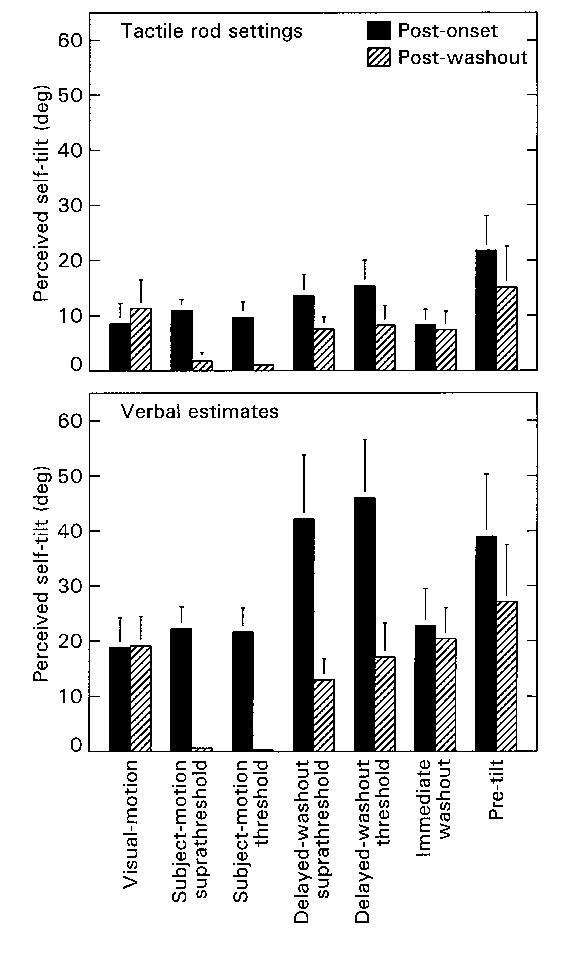
Figure 5.4. Mean angle of perceived self-tilt during the post-onset and
post-washout phases in the concordant-motion conditions. Settings of the tactile
rod (upper) and Verbal estimates of tilt (lower). Bars are standard errors of
the means (n=9).
tilt, which is about 20º according
to the verbal estimate in the subject-motion conditions. This value is similar
to the experienced self-tilt in the visual-motion condition. Thus, as in the
concordant washout conditions, the combination of body tilt and visual motion
induced an effect no greater than the sum of effects produced by the corresponding
visual-motion and the subject-motion conditions. After washout of the subject
to the vertical, estimated self-tilt changed in the same direction and was no
longer different from that in the visual-motion condition (9.7 ±3.2 in suprathreshold
condition; 19.1 ±4.2 in subthreshold condition).
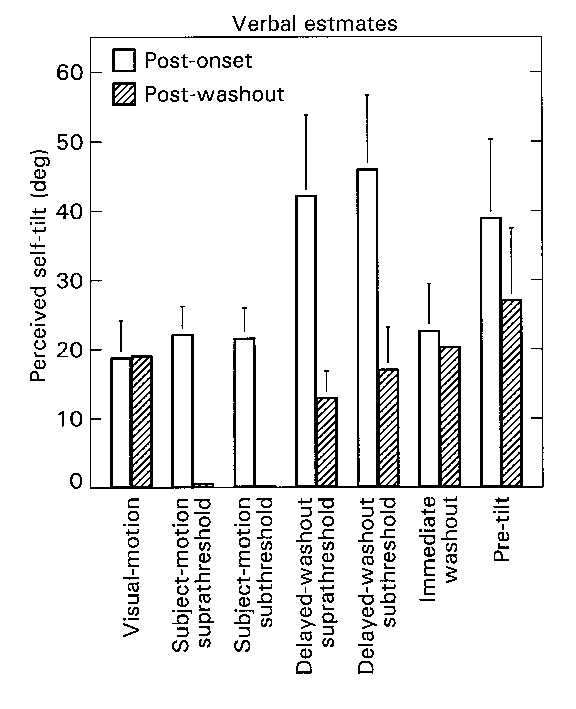
Figure 5.5. Mean vection magnitude in the post-onset and post-washout phases
of the concordant-motion conditions. Vection was scored on a scale of zero to
four. The bars are standard errors of the means (n=10).
There were no significant
differences in vection magnitude between the concordant and discordant combined-motion
conditions. In the post-onset phase the mean vection magnitude was 2.5±0.3 in
the discordant suprathreshold condition, and 2.3±0.3 in the discordant subthreshold
condition. After washout these values were 2.0±0.3 and 2.35±0.3, respectively,
which is not significantly different from the post-onset values.
Discussion
In this study we investigated whether
passive body motion accompanying motion of a visual scene about the horizontal
roll axis affects the latency and magnitude of sensations of self-tilt and self-motion
(vection). The magnitude of perceived tilt was greater when visual motion was
accompanied by concordant tilt of the subject than when there was only visual
motion or only subject tilt. This is what one would expect from addition of
the response to body tilt and that to visual motion. Because the magnitude of
perceived tilt did not depend on the level of subject acceleration, we conclude
that the increase in perceived tilt was merely due to the tilt component of
the subject roll stimulus - and not to the rotation component. Sensations of
self-motion, as opposed to self-tilt, were not much affected by whether visual
motion was or was not accompanied by real self-motion or real self-tilt.
There seem to have been few studies
on the additivity of visual and vestibular contributions to perceived self-tilt.
It has been shown that the effects of a rotating or tilted display on sensations
of vection and self-tilt are larger when the head is in a tilted position (Asch
and Witkin 1948; Held et al. 1975; Bishof 1978; Young et al. 1975). This non-linearity
is attributed to the sensitivity of the utricles being higher when the head
is erect than when it is tilted. As a result, otolith inputs would be less reliable
when the head is tilted, resulting in a lower weighting of otolith inputs relative
to visual inputs. We did not find that actual tilt facilitated visually-induced
self-tilt. When corrected for the response to real body tilt, perceived tilt
in the washout conditions was not different from that in the visual-motion condition.
It is likely that the angle of 15º was too small to produce sufficient change
in otolith sensitivity.
For rotation about the vertical
yaw axis Zacharias and Young (1981) found that the threshold for detection of
self-motion was reduced when visual motion was accompanied by real self-motion.
With vertical yaw motion, however, semicircular canal inputs are involved but
not otolith inputs. They proposed a model in which visual and vestibular inputs
are combined with weightings which depend on whether visual inputs are consistent
with vestibular inputs. Inconsistent vestibular inputs were assigned higher
weightings than consistent vestibular inputs. Our results showed signs of linear
addition when visual and vestibular inputs were consistent. However, when the
two inputs were in conflict, the results were so variable that the additive
model could not be tested.
When the body was rotated along
with the visual stimulus and then returned to vertical, perceived self-tilt
in the erect observer was the same as it would have been if the body had not
moved. Thus the effects of real self-tilt on the magnitude of sensations of
self-tilt persist when the body remains in a tilted position but do not persist
after the body has returned to the vertical. In the typical washout sequence
in a motion-base flight simulator, the body is returned to the vertical at near
threshold acceleration immediately after being accelerated with the visual scene,
as in our immediate-washout condition. Under these conditions, washout produces
only a momentary potentiation of sensations of self-tilt while the body is tilted,
but the effect does not outlast the washout procedure. From these results we
expect that when a motion base executes a series of washout movements in close
succession, the magnitude of illusory self-tilt will be larger than that produced
by visual motion alone.
The main effect of body roll
was a reduction of the latency of detection of self-motion. The latency of tilt
sensations was shorter when suprathreshold body motion and visual motion were
combined compared with when the visual scene alone was rotated, and was similar
to the latency of indicating real body motion alone. A reduction in latency
in a flight simulator means that the subject will show less phase lag in his
response to the simulated motion. Gundry (1977) distinguished between "maneuver
motion" arising from the pilot’s control of the aircraft, and "disturbance
motion" arising from turbulence or aircraft failure. There has been conflicting
evidence about whether motion bases in flight simulators improve pilot training,
as reflected in transfer from simulator to actual flight. In general, performance
has been found to improve under disturbance motion, but not under maneuver motion.
When performance improved, pilot reactions were more rapid and accurate with
motion-based training than without motion-based training (Caro 1979). In addition,
learning time and error rate of a visual tracking task improved when visual
motion was accompanied by concordant body motion. Since disturbance motion is
imposed on the subject without warning, responses should have longer latency
than those to maneuver motion. In maneuver motion, subjects can anticipate the
motion of the aircraft and, under these circumstances, latency will be short
without a motion base. Also, with disturbance motion, reaction time should be
longer in the absence of real self motion than in the presence of real self
motion.
We used body roll as the vestibular
onset cue for self-tilt. This paradigm is not appropriate to simulate the vestibular
stimulation arising from banked turns. A banked turn of a real aircraft generates
a centrifugal force in excess of 1g to which the pilot’s body and the otolith
organs remain aligned (Gilson et al. 1973). In real tilt of a motion base the
otolith organs are displaced relative to gravity and there is no g-excess. Similar
differences between real flight and motion-base simulation exist in pitch maneuvers
(Cramer and Wolfe 1970). Differences of this type probably account for why the
pilot’s ratings of fidelity of motion sensations in a flight simulator were
not related to large changes in the motion of a motion base (Bussolari et al.
1987).
The visual display used in the
present study was lined with dots which gave no indication of "up"
and "down" (visual polarity). Visual motion alone of a whole-field
stimulus does not completely override the contradictory information from the
otolith organs in an erect observer, resulting in combined sensations of continuous
vection and limited self-tilt (Howard et al. 1988). To override the otolith
inputs completely, one needs a visual stimulus containing clear horizontal and
vertical lines (visual frame) and features with a top and bottom, such as chairs
and tables. Howard and Childerson (1994) showed that more than 60% of erect
observers reported sensations of head-over-heels rotation (360º of self-tilt)
when placed inside an 7-foot cubic furnished room with abundant visual polarity
cues, rotating about the line of sight. However, when exposed to static tilt
of the furnished room up to 120º, the mean perceived self-tilt was at most 15º.
The larger effects produced by the moving room are presumably due to the combined
effects of motion, the visual frame and visually polarized objects. It therefore
seems that the most effective visual stimulus to induce apparent self-tilt in
an upright observer is a moving polarized scene. We conclude that apparent self-tilt
can be enhanced by a typical washout sequence of real body tilt, but only during
the actual tilt. More importantly, the latency of perceived self-tilt is greatly
reduced when visual motion is accompanied by suprathreshold body rotation. We
found no effects of actual body tilt on sensations of self-rotation.
Acknowledgments
This work was supported by Defence
and Civil Institute for Environmental Medicine (DCIEM) contract No. W7711-5-7256
awarded to Dr. Ian Howard.




